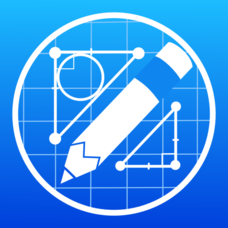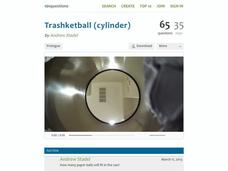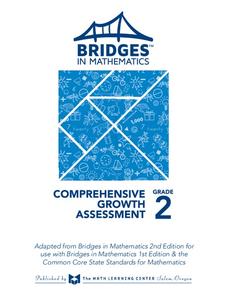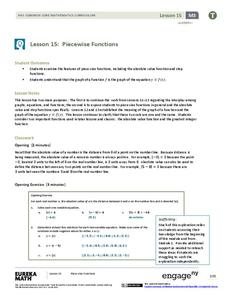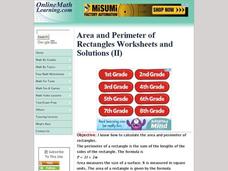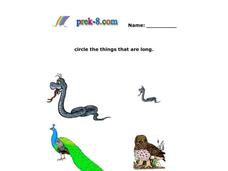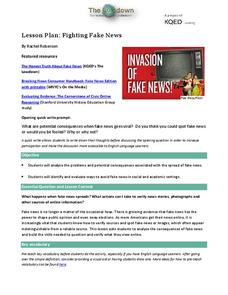Bytes Arithmetic
Geometry Pad+
Graphing paper, pencil, ruler, protractor, and compass, all get replaced or supplemented with this dynamic geometry application. Here, you can create, move, and scale many different shapes, as well as, explore and change their properties...
Virginia Department of Education
Surface Area and Volume of a Cylinder
Surface area or volume? Pupils first review the difference between surface area and volume. They then use a two-dimensional net that helps them develop formulas for the surface area and volume of cylinders.
101 Questions
Trashketball
Take a shot using a lesson on volume! Young learners watch a video showing a trashcan filling with paper balls. The task is to calculate the number of paper balls that will fit in the can. Pupils use volume calculations to make a...
Curated OER
Practice: Word Problems
Congratulations, you've just hit the word problem jackpot! Covering an incredible range of topics from integers and fractions, to percents, geometry, and much more, this collection of worksheets will keep young mathematicians busy...
Bridges In Mathematics
Grade 2 Comprehensive Growth Assessment
Need to know if your students comprehend all the Common Core standards covered in second grade? This growth assessment will let you know. Find out if your second graders can add/subtract, tell the time, read a bar graph, know their...
Los Angeles County Office of Education
Assessment For The California Mathematics Standards Grade 4
Have scholars show what they know with a 20-page assessment aligned to the California State Standards. The test covers concepts such as large and whole numbers, all four mathematical operations, fractions, decimals, geometric figures,...
It's About Time
Refraction of Light
Don't shine like a diamond, refract light like a diamond. Young scientists use an acrylic block and a laser light to observe refraction. Advanced scholars figure the sine of the angles of reflection and incidence as well as mastering...
Close Up Foundation
Teach the Vote
Why is voting important? A social studies unit presents a non-partisan approach to the importance of voting, to voting laws and procedures, and to resources that voters need to become informed voters.
EngageNY
Piecewise Functions
Show your class members that if they can graph a linear function, they can graph an absolute value function. Groups create an absolute value graph using a table, then entertain the idea of an absolute value function defined as two pieces...
Mathed Up!
Pie Charts
Representing data is as easy as pie. Class members construct pie charts given a frequency table. Individuals then determine the size of the angles needed for each sector and interpret the size of sectors within the context of frequency....
Weber State University
The Sun and the Seasons
Why is there more daylight in June than in December if you live above the equator? How does the angle of sunlight shift throughout the year? Answer these questions and more with an interactive article about the sun, its path through the...
Curated OER
Color Larger Shapes
In this larger shapes worksheet, students color the larger shape in a pair, 6 pairs total. Shapes used are circles, squares, rectangles, triangles and polygons.
Curated OER
Surface Area and Volume of a Cylinder
Seventh graders find the surface area and volume of a cylinder. In this area and volume instructional activity, 7th graders complete several activities to learn the volume and surface area of cylinders.
Curated OER
Ship Shape
Second graders explore shapes and create a Silly Shape book. Students recognize that shapes have certain properties and be able to define them. Example, a triangle is any three-sided shape. Students' job is to make a picture on...
Curated OER
Compare Length and Height
In this comparing length and height word problem learning exercise, students compare drawings of objects visually to determine which is longer, longest, shorter, and shortest and make a chart to solve logical reasoning problems. Students...
Curated OER
Identify the Shape
10 this geometry worksheet, students identify the different angles created by polygons and name the shape created based on the number of sides. There is an answer key.
Curated OER
Globe Lesson 4 - The Compass
Students study compass' and their use in navigation. In this compass lesson, students use a compass and a globe to answer the questions about navigation.
Curated OER
Graph it!
Sixth graders view a Stacked Graph, and discuss what it shows. Students discuss the basics of graphing: labels, intervals, legends x and y axis... Students create individual stacked graphs from provided information. Students view a...
Curated OER
Area and Perimeter of Rectangles Worksheet (II)
In this geometry worksheet, 10th graders determine area and perimeter of rectangles, given the width and the length. The one page interactive worksheet contains ten questions. Answers and hints are included.
Curated OER
Math: The Bone connection
Learners examine the connection between bones of the human body and math. In groups, they locate bones and determine which instruments are used for measuring. Students organize their findings and create spreadsheets for calculating and...
Curated OER
Comparing Length
In this length comparison worksheet, students study the images illustrated on the page. Students identify the image that is longer and circle it.
Curated OER
Length of an Arc
Twelfth graders define an arc and find its length. In this calculus lesson plan, 12th graders roll out a circle and measure its length using the same method of a triangle and its hypotenuse. They apply the Pythagorean Theorem to some...
Curated OER
Fighting Fake News
Fake news. Alternative facts. Internet trolls. In an age of Newspeak, it's increasingly important to equip 21st century learners with the skills needed to determine the legitimacy of claims put forth on social media, in print, and in...
Curated OER
Plain Figures And Measuring Figures
Seventh graders investigate the mathematical concept of a sector. They apply the concept to an example problem and then move into a more complex application. They find the area of the side of a cone. This is done as students calculate...


